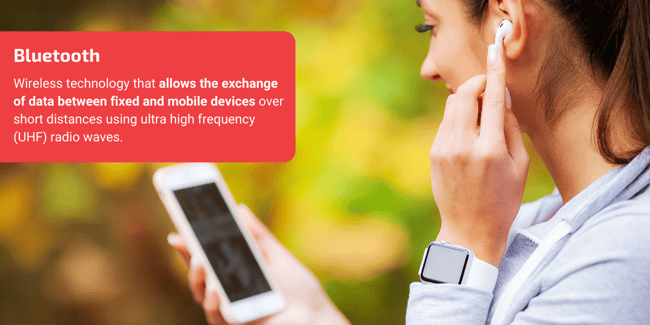Nowadays numerous technological trends are fuelling a digital revolution in various industries, and access control is no exception.
More and more wireless technologies are appearing in the security arena, offering solutions to different applications and needs.
NFC and Bluetooth technologies are the biggest players in this field, with what can seem like similar features.
Both technologies enable the connection between two devices over short ranges, providing a reliable communication path for devices to transfer the data.
However, that's where the similarity ends as, beyond that, Bluetooth and NFC are quite different. In this Nortech article, you'll learn:
- What Bluetooth technology is and how it works
- What Near-Field Communication (NFC) is and how it works
- The key differences between NFC and Bluetooth
What Is Bluetooth?
Bluetooth is a wireless technology that enables data exchange between fixed and mobile devices over short distances. It utilises UHF radio waves in the ranges between 2.402 GHz and 2.480 GHz.
Bluetooth utilises a radio technology called frequency-hopping spread spectrum. It divides transmitted data into packets and transmits each packet on one of 79 designated Bluetooth channels. Each channel has a bandwidth of 1 MHz.

In access control, the devices are usually based on Bluetooth Low Energy (BLE) which offers high energy efficiency and performance. Systems utilising BLE technology can work for months solely on a single cell battery.
For an access control system to work through Bluetooth technology, it requires a direct connection between the Bluetooth device and the controller, with the help of a software.
As smartphones are becoming inseparable part of our lives, more and more companies are looking at ways to integrate mobile devices into access control solutions. Bluetooth-enabled phones continue to become a norm, which naturally leads to the introduction of digital keys.
Our mobile phones are always on our reach – it's rare to see people leaving the house without their phone. This makes it a perfect device to add to an access control system.
Users find it more convenient to use as an access control credential, as they don't need to carry cards/fobs with them or worry about memorising a PIN code.
What Is Near-Field Communication? (NFC)
Before we jump into the key differences between these innovative wireless technologies, let’s take a peek at NFC definition.
NFC or Near Field Communication is also a wireless technology that enables short-range communication between compatible devices at a frequency of 13.56 MHz. NFC requires at a minimum one transmitting device and another to receive the signal.
NFC technology operates on an alternating magnetic field, meaning that no power is emitted in the form of radio waves. This prevents any interference from occurring between similar devices or any radio communications operating at the same frequency.
The NFC-enabled system includes an initiator (a reader) and a target (tag, card, sticker or a key fob). NFC tags contain data and tend to be read-only. These tags can securely hold personal data, with memory ranging between 96 and 8,192 bytes.
Bluetooth Vs. NFC: The Key Differences
So, now that we have that out of the way, let’s look at the key differences between NFC and Bluetooth…
Operating Distance
NFC tends to operate on a shorter distance – less than 4 cm, whilst Bluetooth offers an operating range of up to 10m. However, this increased range can come at a cost. Bluetooth is more likely to have interference in transmission due to its longer range, whereas NFC’s shorter distance enables a stronger connection with no interference.
Technology Setup
Bluetooth requires a manual setup to pair the devices. In most cases, you will need to enter a PIN code and configure some settings to pair the devices.
On the other hand, the NFC connection is quite easy to establish with no authentication needed. With NFC enabled devices, all you need to do is to turn the devices on and bring them within proximity of each other. The data transfer via NFC technology happens instantaneously and doesn't require any additional hassle.
Power Usage
In most cases, NFC consumes less power than Bluetooth devices. It operates on a low-power radio transmitter/receiver and doesn't affect the battery of the device much. As such, NFC can be kept 'ON' all the time without draining the battery too much.
The only instance where NFC would require more power than Bluetooth is when it's powering a passive, unpowered source. The only exception is when the device utilises BLE technology, which tends to use less power than NFC powered devices.
RFID Compatibility
NFC has a unique ability to work with passive RFID tags, therefore it’s more convenient to use with an existing RFID-enabled access control system. Bluetooth, on the other hand, is not compatible with RFID and hence less flexible than NFC.
Security
NFC tends to be more secure than Bluetooth, as it operates on a shorter range allowing for a more stable connection. Therefore, NFC tends to be a better solution for crowded and busy places, where a lot of different devices are trying to communicate with each other, creating signal interference.
On the other hand, even though Bluetooth has a PIN-based authentication, it still faces security issues and can be quite vulnerable to hacker attacks.
NFC vs Bluetooth: Summary
So, whilst both NFC and Bluetooth technologies are similar in that they both involve wireless transfer methods, beyond that they have very different capabilities.
NFC is best used over short distances to securely send small amounts of data, hence is commonly used for access control and payments.
On the other hand, Bluetooth, whilst not as secure opens up a larger connection range and is most often used on wireless devices such as headphones and audio speakers.

